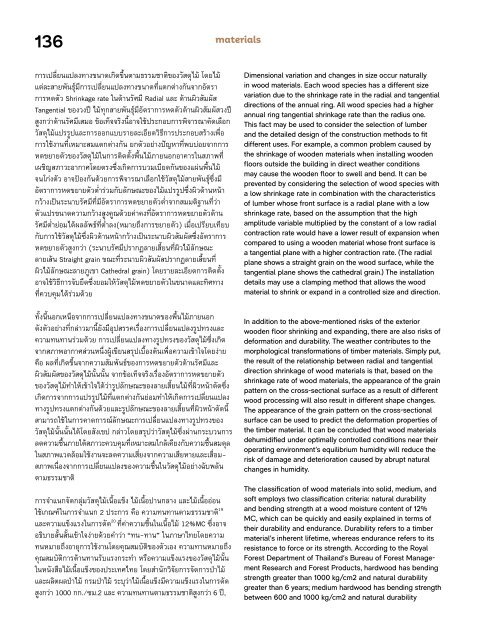ASA JOURNAL 14/2023
You also want an ePaper? Increase the reach of your titles
YUMPU automatically turns print PDFs into web optimized ePapers that Google loves.
136<br />
materials<br />
การเปลี่ยนแปลงทางขนาดเกิดขึ้นตามธรรมชาติของวัสดุไม้ โดยไม้<br />
แต่ละสายพันธุ์มีการเปลี่ยนแปลงทางขนาดที่แตกต่างกันจากอัตรา<br />
การหดตัว Shrinkage rate ในด้านรัศมี Radial และ ด้านผิวสัมผัส<br />
Tangential ของวงปี ไม้ทุกสายพันธุ์มีอัตราการหดตัวด้านผิวสัมผัสวงปี<br />
สูงกว่าด้านรัศมีเสมอ ข้อเท็จจริงนี้อาจใช้ประกอบการพิจารณาคัดเลือก<br />
วัสดุไม้แปรรูปและการออกแบบรายละเอียดวิธีการประกอบสร้างเพื่อ<br />
การใช้งานที่เหมาะสมแตกต่างกัน ยกตัวอย่างปัญหาที่พบบ่อยจากการ<br />
หดขยายตัวของวัสดุไม้ในการติดตั้งพื้นไม้ภายนอกอาคารในสภาพที่<br />
เผชิญสภาวะอากาศโดยตรงซึ่งเกิดการบวมเบียดกันของแผ่นพื้นไม้<br />
จนโก่งตัว อาจป้องกันด้วยการพิจารณาเลือกใช้วัสดุไม้สายพันธุ์ซึ่งมี<br />
อัตราการหดขยายตัวต่ำาร่วมกับลักษณะของไม้แปรรูปซึ่งผิวด้านหน้า<br />
กว้างเป็นระนาบรัศมีที่มีอัตราการหดขยายตัวต่ำาจากสมมติฐานที่ว่า<br />
ตัวแปรขนาดความกว้างสูงคูณด้วยค่าคงที่อัตราการหดขยายตัวด้าน<br />
รัศมีต่ำาย่อมได้ผลลัพธ์ที่ต่ำาลง(หมายถึงการขยายตัว) เมื่อเปรียบเทียบ<br />
กับการใช้วัสดุไม้ซึ่งผิวด้านหน้ากว้างเป็นระนาบผิวสัมผัสซึ่งอัตราการ<br />
หดขยายตัวสูงกว่า (ระนาบรัศมีปรากฏลายเสี้ยนที่ผิวไม้ลักษณะ<br />
ลายเส้น Straight grain ขณะที่ระนาบผิวสัมผัสปรากฏลายเสี้ยนที่<br />
ผิวไม้ลักษณะลายภูเขา Cathedral grain) โดยรายละเอียดการติดตั้ง<br />
อาจใช้วิธีการจับยึดซึ่งยอมให้วัสดุไม้หดขยายตัวในขนาดและทิศทาง<br />
ที่ควบคุมได้ร่วมด้วย<br />
ทั้งนี้นอกเหนือจากการเปลี่ยนแปลงทางขนาดของพื้นไม้ภายนอก<br />
ดังตัวอย่างที่กล่าวมานี้ยังมีอุปสรรคเรื่องการเปลี่ยนแปลงรูปทรงและ<br />
ความทนทานร่วมด้วย การเปลี่ยนแปลงทางรูปทรงของวัสดุไม้ซึ่งเกิด<br />
จากสภาพอากาศส่วนหนึ่งผู้เขียนสรุปเบื้องต้นเพื่อความเข้าใจโดยง่าย<br />
คือ ผลที่เกิดขึ้นจากความสัมพันธ์ของการหดขยายตัวด้านรัศมีและ<br />
ผิวสัมผัสของวัสดุไม้นั้นนั้น จากข้อเท็จจริงเรื่องอัตราการหดขยายตัว<br />
ของวัสดุไม้ทำาให้เข้าใจได้ว่ารูปลักษณะของลายเสี้ยนไม้ที่ผิวหน้าตัดซึ่ง<br />
เกิดการจากการแปรรูปไม้ที่แตกต่างกันย่อมทำาให้เกิดการเปลี่ยนแปลง<br />
ทางรูปทรงแตกต่างกันด้วยและรูปลักษณะของลายเสี้ยนที่ผิวหน้าตัดนี้<br />
สามารถใช้ในการคาดการณ์ลักษณะการเปลี่ยนแปลงทางรูปทรงของ<br />
วัสดุไม้นั้นนั้นได้โดยสังเขป กล่าวโดยสรุปว่าวัสดุไม้ซึ่งผ่านกระบวนการ<br />
ลดความชื้นภายใต้สภาวะควบคุมที่เหมาะสมใกล้เคียงกับความชื้นสมดุล<br />
ในสภาพแวดล้อมใช้งานจะลดความเสี่ยงจากความเสียหายและเสื่อม-<br />
สภาพเนื่องจากการเปลี่ยนแปลงของความชื้นในวัสดุไม้อย่างฉับพลัน<br />
ตามธรรมชาติ<br />
การจำาแนกจัดกลุ่มวัสดุไม้เนื้อแข็ง ไม้เนื้อปานกลาง และไม้เนื้ออ่อน<br />
ใช้เกณฑ์ในการจำาแนก 2 ประการ คือ ความทนทานตามธรรมชาติ19<br />
และความแข็งแรงในการดัด 20 ที่ค่าความชื้นในเนื้อไม้ 12%MC ซึ่งอาจ<br />
อธิบายสั้นสั้นเข้าใจง่ายด้วยคำาว่า “ทน-ทาน” ในภาษาไทยโดยความ<br />
ทนหมายถึงอายุการใช้งานโดยคุณสมบัติของตัวเอง ความทานหมายถึง<br />
คุณสมบัติการต้านทานรับแรงกระทำา หรือความแข็งแรงของวัสดุไม้นั้น<br />
ในหนังสือไม้เนื้อแข็งของประเทศไทย โดยสำานักวิจัยการจัดการป่าไม้<br />
และผลิตผลป่าไม้ กรมป่าไม้ ระบุว่าไม้เนื้อแข็งมีความแข็งแรงในการดัด<br />
สูงกว่า 1000 กก./ซม.2 และ ความทนทานตามธรรมชาติสูงกว่า 6 ปี,<br />
Dimensional variation and changes in size occur naturally<br />
in wood materials. Each wood species has a different size<br />
variation due to the shrinkage rate in the radial and tangential<br />
directions of the annual ring. All wood species had a higher<br />
annual ring tangential shrinkage rate than the radius one.<br />
This fact may be used to consider the selection of lumber<br />
and the detailed design of the construction methods to fit<br />
different uses. For example, a common problem caused by<br />
the shrinkage of wooden materials when installing wooden<br />
floors outside the building in direct weather conditions<br />
may cause the wooden floor to swell and bend. It can be<br />
prevented by considering the selection of wood species with<br />
a low shrinkage rate in combination with the characteristics<br />
of lumber whose front surface is a radial plane with a low<br />
shrinkage rate, based on the assumption that the high<br />
amplitude variable multiplied by the constant of a low radial<br />
contraction rate would have a lower result of expansion when<br />
compared to using a wooden material whose front surface is<br />
a tangential plane with a higher contraction rate. (The radial<br />
plane shows a straight grain on the wood surface, while the<br />
tangential plane shows the cathedral grain.) The installation<br />
details may use a clamping method that allows the wood<br />
material to shrink or expand in a controlled size and direction.<br />
In addition to the above-mentioned risks of the exterior<br />
wooden floor shrinking and expanding, there are also risks of<br />
deformation and durability. The weather contributes to the<br />
morphological transformations of timber materials. Simply put,<br />
the result of the relationship between radial and tangential<br />
direction shrinkage of wood materials is that, based on the<br />
shrinkage rate of wood materials, the appearance of the grain<br />
pattern on the cross-sectional surface as a result of different<br />
wood processing will also result in different shape changes.<br />
The appearance of the grain pattern on the cross-sectional<br />
surface can be used to predict the deformation properties of<br />
the timber material. It can be concluded that wood materials<br />
dehumidified under optimally controlled conditions near their<br />
operating environment’s equilibrium humidity will reduce the<br />
risk of damage and deterioration caused by abrupt natural<br />
changes in humidity.<br />
The classification of wood materials into solid, medium, and<br />
soft employs two classification criteria: natural durability<br />
and bending strength at a wood moisture content of 12%<br />
MC, which can be quickly and easily explained in terms of<br />
their durability and endurance. Durability refers to a timber<br />
material’s inherent lifetime, whereas endurance refers to its<br />
resistance to force or its strength. According to the Royal<br />
Forest Department of Thailand’s Bureau of Forest Management<br />
Research and Forest Products, hardwood has bending<br />
strength greater than 1000 kg/cm2 and natural durability<br />
greater than 6 years; medium hardwood has bending strength<br />
between 600 and 1000 kg/cm2 and natural durability


















